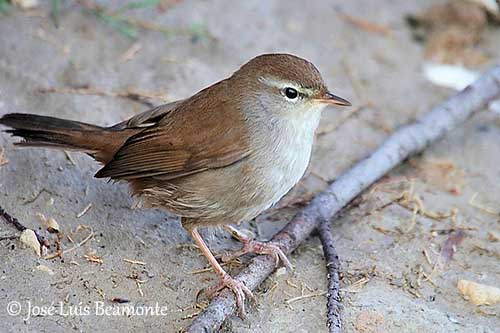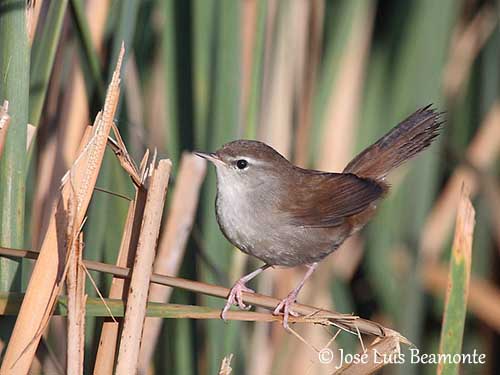
Fr: Bouscarle de Cetti
Ang: Cetti’s Warbler
All: Seidensänger
Esp: Cetia Ruiseñor
Ita: Usignolo di fiume
Nd: Cetti's Zanger
Sd: Cettisångare
Photographers:
José Luis Beamonte
Pájaros de España
Jean Michel Fenerole
Photos d’Oiseaux du monde
Jean-Claude Jamoulle
A la rencontre des Oiseaux
Otto Plantema
Trips around the world
Text by Nicole Bouglouan
Sources:
HANDBOOK OF THE BIRDS OF THE WORLD Vol 11 by Josep del Hoyo, Andrew Elliott and David Christie - Lynx Edicions - ISBN: 849655306X
ENCYCLOPEDIE DES OISEAUX DE FRANCE ET D’EUROPE – de Peter Hayman et Rob Hume - Flammarion – ISBN : 2082009920
THE COMPLETE BOOK OF BRITISH BIRDS – Written by “Royal Society for the Protection of Birds” experts - Préface de Magnus Magnusson - Michael Cady- Rob Hume Editors - ISBN: 0749509112
THE HANDBOOK OF BIRD IDENTIFICATION FOR EUROPE AND THE WESTERN PALEARCTIC by Mark Beaman, Steve Madge - C. Helm - ISBN: 0713639601
BirdLife International (BirdLife International)
Pájaros de España (JL Beamonte)
Birds of Britain - The Web Magazine for Birdwatchers
Wikipedia, the free encyclopaedia
Cetti’s Warbler
Cettia cetti
Passeriformes Order – Cettiidae Family
INTRODUCTION:
The Cetti’s Warbler is a species living in wet areas with dense vegetation. Its presence is often revealed by the loud, explosive bursts of song coming from the dense waterside undergrowth, but the bird is usually well-hidden and rarely seen.
The name of this Old World warbler pays tribute to the 18th century Italian zoologist Francesco Cetti.
DESCRIPTION OF THE BIRD:
Biometrics:
Length: 14 cm
Weight: M: 15g – F: 12g
The adult is a stocky warbler with mostly short, rounded wings and tail.
The nominate race has warm rufous-brown upperparts, but flight feathers and tail are browner. The rectrices show rufous-brown outer edges.
The underparts are white to pale grey with brownish tinge on sides of breast, and reddish-brown wash on flanks and undertail-coverts, the latter with narrow whitish tips.

On the head, forehead, crown and nape are rufous-brown. We can see a narrow, white to pale grey supercilium fading on the ear-coverts. Lores and eye stripe are dark. There is a thin, whitish, broken eyering. Cheeks and ear-coverts are grey-brown.
The short, pointed bill is dark brown to blackish, with pinkish base of lower mandible. The eyes are dark brown. Legs and feet are pale brown to pinkish.
Male and female have similar plumage, but the male is 25-30% heavier than the female.
The juvenile is duller than adults.
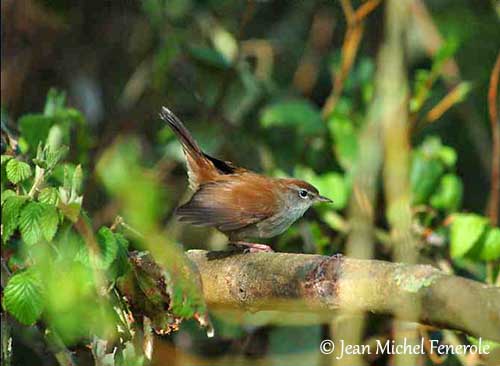
SUBSPECIES AND RANGE:
The Cetti’s Warbler has three recognized subspecies.
C.c. cetti (described and displayed) is found in W Europe and N Coast of Mediterranean, throughout Greece and much of S Balkans, E to W and NW Black Sea coast. It also occurs in NW Africa (Morocco E to Tunisia).
C.c. orientalis (displayed) is found in Crimea and Turkey, E to Iraq, N Iran and N Afghanistan.
This race has less rufous upperparts than nominate, more olive-grey. The underparts are whiter and the supercilium is slightly more conspicuous.
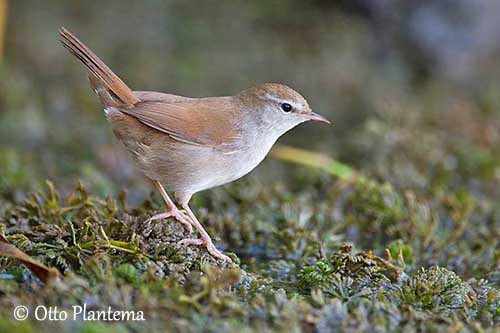
C.c. albiventris occurs in N Kazakhstan E to Balkhash and extreme NW China, S to Turkmenistan, Uzbekistan and NW Afghanistan. It is non-breeding in S Iran, S Afghanistan and Pakistan, and NW India.
This race is larger than “orientalis” with paler olive-brown upperparts and whitish underparts, grey-brown flanks and dull brown undertail-coverts with pale tips.
HABITAT:
The Cetti’s Warbler frequents wet areas with thick vegetation, patches of willows, brambles or blackthorn, bushes and reeds, close to lakes, rivers, marshes, streams and ditches. It is usually hidden in dense, low scrub close to the water and along the edges of small woods with thick understorey.
The non-breeding areas are wet or dry scrubs of plains, foothills and valley bottoms, and orchards, palm groves and usually dense cover near water.
This species breeds up to 1450 metres in Spain, and was recorded up to 2450 metres on passage in Tien Shan.
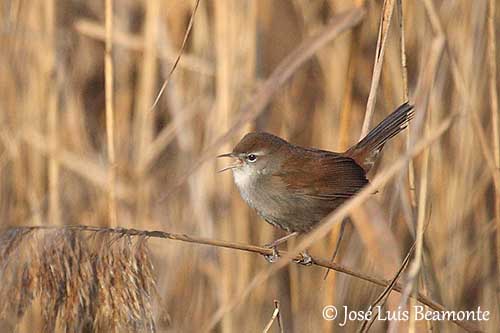
CALLS AND SONGS: SOUNDS BY XENO-CANTO
The Cetti’s Warbler’s calls include a sharp, abrupt “chip” or “chee”, and a loud, sharp “tsuk”. The alarm call is a hard, wren-like “tett-tett-tett…”
The song is given mostly by the male from a well-concealed perch. This is a far-carrying sound, an astonishingly loud, explosive outburst of abrupt notes “plit-plitiplitipliti-pliti-pliti”.
This song is given from several regular perches within the breeding territory. The successive bursts of song are intermittent and rarely uttered from the same perch.
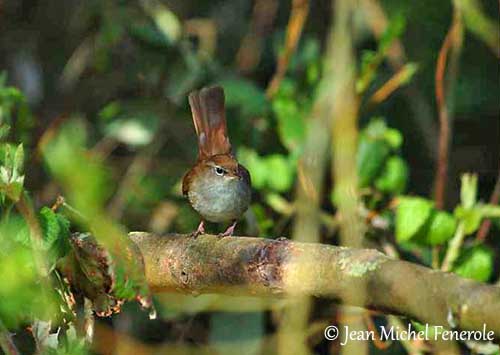
BEHAVIOUR IN THE WILD:
The Cetti’s Warbler feeds mainly on invertebrates such as insects and spiders, but also aquatic invertebrates gleaned from the vegetation close to the water. Snails, earthworms and molluscs are taken too and occasionally small seeds.
It forages in low, thick vegetation. It moves by hopping in wren-like fashion, flicking both wings and tail through the undergrowth.
It also takes invertebrates from water surface, and occasionally pursues insects in flight.
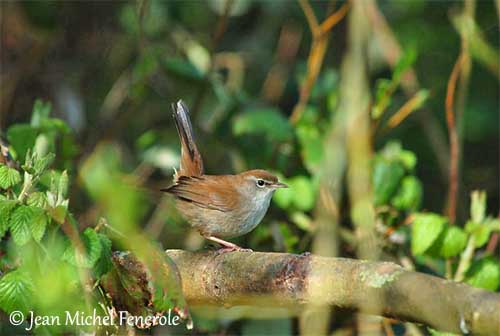
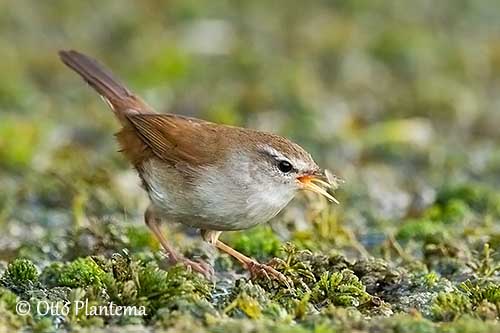
During the breeding season, they are frequently polygamous as the pair-bonds are not strong. The male sings and calls in courtship, and the female utters soft notes in response. Then, she rapidly flicks wings and tail while adopting a submissive posture. The male joins her and continues to sing and call. One minute later, both birds move off and perform chase-displays, often during more than five minutes through the dense vegetation in their territory.
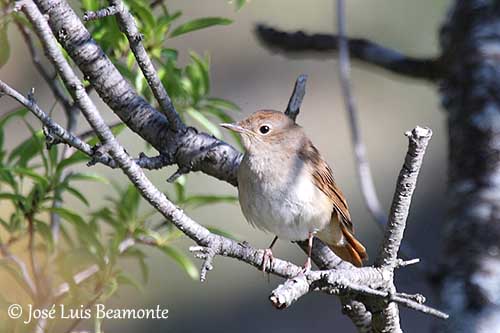
The Cetti’s Warbler of nominate race is mainly sedentary, but it may perform partial and altitudinal movements. The race “orientalis” also performs altitudinal movements. The race “albiventris” is mainly migratory and moves S to winter, reaching S Iran, Afghanistan and NW Indian subcontinent.
The Cetti’s Warbler is well-adapted to its life in dense vegetation with combination of short, rounded wings and tail. The bird moves rapidly into the thick vegetal cover.
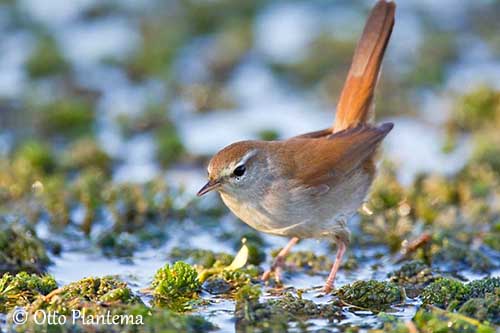
REPRODUCTION OF THIS SPECIES:
The breeding season occurs between April and July/August. The Cetti’s Warbler usually produces two broods per season.
The nest is placed in low vegetation, up to 2 metres above the ground, in a thick tangle of branches, reed stems or twigs. The large cup is made with dry grass, leaves, plant fibres, reed mace and feathers and /or animal hair.
The territory is maintained by the male over several following years, and extends along watercourses or sometimes in reedbeds.
The female lays 2-4 brick-red eggs and incubates alone during 16-17 days. The chicks are fed on invertebrates by the female, mainly insects. They fledge about two weeks after hatching. They are fed by both parents for 15 days after fledging. The male defends the territory and the nest-site, while the female raises the chicks.
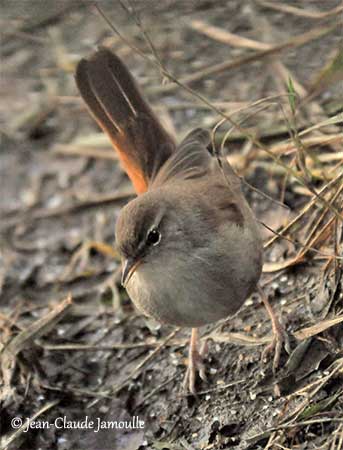
PROTECTION / THREATS / STATUS:
The Cetti’s Warbler has large range where it is relatively common.
The global population was estimated in 2004, at about 3,670,000/19,200,000 individuals. It is suspected to be increasing with an expansion to North in the West of the range.
The Cetti’s Warbler is currently evaluated as Least Concern.
